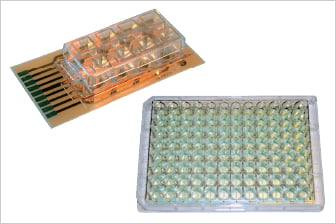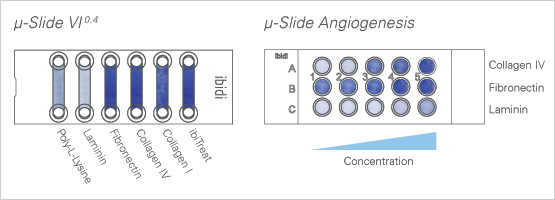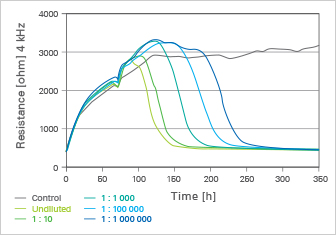Cell Attachment
Impedance Measurements
The interaction between surfaces and cells is a main component of cell behavior in vivo and in vitro and therefore an area of major interest in cell biology studies. ECIS allows researchers to study and quantify the interaction of cultured cells with extracellular matrix proteins, and other macromolecules by taking continuous, real-time impedance measurements.
Cell attachment and spreading can be analyzed at high frequencies using the impedance and capacitance, as these elements reflect the cell membranes. For the analysis, the rate of cell spreading scales with the adhesion to the surface and the time course of the impedance mirrors the spreading of the cells dependent on the coating protein.
For further information:
Wegener J, Keese CR, Giaever I. Electric cell-substrate impedance sensing (ECIS) as a noninvasive means to monitor the kinetics of cell spreading to artificial surfaces, Exp Cell Res, 2000, 10.1006/excr.2000.4919.
Read article

Used electrode arrays for cell attachment & spreading:
|
8 well format: |
96 well format: |

Optical Measurements
Optical measurements of cell attachment rates are taken using ibidi’s μ-Slide VI 0.4 and μ-Slide Angiogenesis.

Studies measuring dose- and time-related toxic effects of chemicals are mostly based on endpoint readouts, either of the cellular metabolic activity or the membrane integrity. The latter is lost during cell death and leads to loss of impedance. For the large-scale monitoring of cell death in real time, ECIS measures the impedance in a label-free manner. Thereby, ECIS effectively describes the relationship between the drug dose and its effects on the exposed organism, including comparisons of LD50 (lethal dose, 50%) values, toxicological effects from heavy metals, and the effects of viral infections on cell populations.
For further information:
Xiao C, Lachance B, Sunahara G, Luong JH. Assessment of cytotoxicity using electric cell-substrate impedance sensing: concentration and time response function approach. Anal Chem. 2002, 10.1021/ac025848f.
Read article

Fish cells challenged with decreasing concentrations of a virus (Campell et al., 2007, Biosensors & Bioelectronics).
The following electrode arrays are ideally suited for toxicological screenings:
|
8 well format: |
96 well format: |

Optical Measurements
Optical measurements of toxicology are possible with all ibidi μ-Slides and μ-Dishes.





